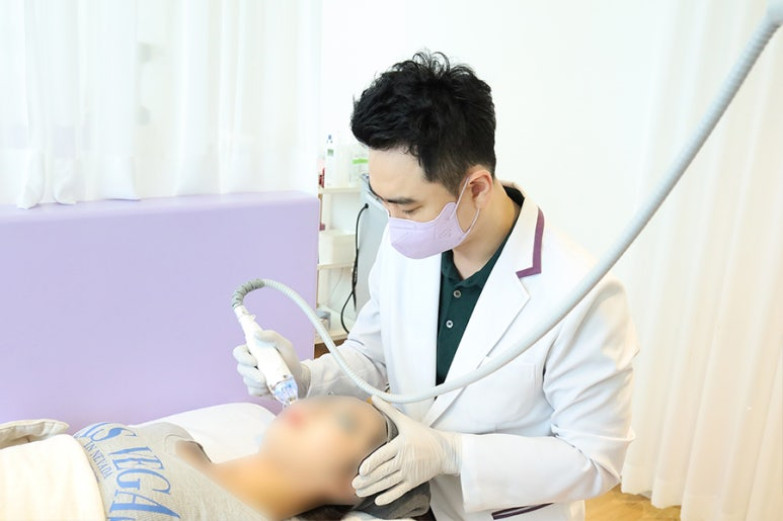Understanding and Treating Enlarged Pores

This post is written directly by Purple Clinic and is intended to provide medical information only. This content does not require prior review as it is not intended for advertising specific pharmaceuticals or medical devices, but solely for providing medical information.
This post complies with Article 56, Paragraph 1 of the Medical Service Act (Prohibition of Medical Advertising, etc.).
Why Do Pores Enlarge?
When we talk about enlarged pores, it's easy to think of them as simply 'bigger holes' in the skin. However, in reality, it's more about the weakening and sagging of the skin's elastic structure around the pores, causing the pore edges to appear stretched.
In other words, it's not just about excessive sebum production. It's a complex issue resulting from damage to the dermal layer's elastic fibers (collagen and elastin) combined with abnormal sebaceous gland function.
Common causes include:
Excessive Sebum Secretion: When there's too much sebum, pores remain in a stretched state, eventually becoming fixed in that condition.
Skin Aging: As collagen decreases due to UV exposure and aging, the dermis supporting the pores weakens, leading to sagging.
Acne and Inflammation Sequelae: Frequent acne and repeated inflammation can damage pores, leading to scar-related enlargement.
Lifestyle Habits: Over-cleansing, frequent scrubbing, heat exposure, and smoking can weaken the skin barrier, making pores more prominent.
Ultimately, pores aren't just 'enlarged holes' but a problem of 'stretched skin structure.' Therefore, simply using astringent cosmetics isn't enough to solve the problem.
Why Cosmetics Alone Can't Shrink Pores
Using astringent toners might give a temporary feeling of tightened pores, but this is just a temporary contraction caused by moisture evaporation on the skin surface.
The root cause of enlarged pores lies in the dermal layer of the skin, so treatments that induce collagen regeneration should be combined.
Functional cosmetics like retinol and niacinamide can help control sebum and exfoliation to some extent, but they can't restore the elasticity of already enlarged pore structures.
That's why most pore treatments involve lasers or radiofrequency procedures that deliver energy deep into the skin.
The Principle and Effects of Pore Lasers
The core principle of pore-treating lasers is simple:
They stimulate collagen regeneration by applying subtle heat to the skin, tightening the edges of the pores.
This process is called 'dermal regeneration,' and over time, the newly created collagen provides firm support to the skin from within.
As a result,
The rough and enlarged pore edges are smoothed out.
The skin texture becomes denser.
The overall skin texture improves, becoming more elastic and smoother.
These effects usually appear gradually over several treatments, spaced 2 to 4 weeks apart.
It's safer and yields more natural results to treat gently multiple times rather than applying a strong stimulus all at once.
Differences Between Fractional and Microneedle RF Methods
Common equipment methods used for pore treatment are fractional lasers and microneedle RF (radiofrequency).
1. Fractional Laser
This method delivers laser heat to the skin in the form of tiny holes, regenerating damaged dermis. It is used not only for pores but also for acne scars, fine wrinkles, and skin texture improvement.
However, depending on the intensity, scabs may form, requiring a downtime of about 7 to 10 days.
2. Microneedle RF
This method inserts fine needles into the skin to deliver radiofrequency (RF) heat directly to the dermal layer.
There is almost no surface damage, and the risk of pigmentation is low, making it relatively safe for people with darker skin tones or during the summer.
It also has the effect of reducing sebum secretion by directly stimulating the sebaceous glands, making it particularly suitable for oily skin and acne-prone pores.
In summary,
Fractional lasers broadly stimulate the skin from the surface to the dermis, while microneedle RF selectively stimulates the dermal layer deeply.
The Principle, Effects, and Advantages of Secret Laser
A representative microneedle RF device is the Secret Laser (Secret RF).
The Secret Laser is a procedure that promotes collagen regeneration by inserting micro-needles into the skin and delivering uniform radiofrequency heat to the dermal layer.
Pore Reduction: Reconstructs collagen in the dermis to strengthen the edges of pores.
Sebum Reduction: Applying heat near the sebaceous glands helps control sebum secretion and is beneficial for acne-prone skin.
Skin Texture Improvement: Regeneration of the dermal layer improves overall skin texture and elasticity.
Short Downtime: There may be redness or swelling for about 1-2 days after the procedure, but it usually does not interfere with daily life.
The advantages of Secret Laser are that it can be performed regardless of skin color or season, and that the depth, power, and density of the procedure can be finely adjusted.
In other words, it means that customized design is possible according to the different skin types of each patient.
Ultimately, What Matters is Skill and Dedication
Even when using the same equipment, the results differ due to the difference in the operator's experience and know-how.
Pore treatment is not simply about operating a machine; it requires a comprehensive assessment of skin thickness, pore depth, sebum distribution, and elasticity to achieve safe and effective results.
Also, pore treatment is not a one-time procedure.
Accurate planning, consistent treatment, sufficient time, and aftercare are all important.
After the procedure, it is important to protect against UV rays, moisturize, minimize irritation, and avoid heat (sauna, strenuous exercise, etc.) to ensure proper regeneration.
In the end, the skill and dedication of the operator are more important than the equipment.
Procedures that take sufficient time to thoroughly examine and carefully observe the skin's reaction are much more stable and satisfactory than procedures that are completed quickly in a short time.
All procedures may vary depending on the individual.
Side effects such as swelling, inflammation, and bleeding may occur, so be careful.







Source :https://blog.naver.com/purpleclinic/224064378207
No comments yet.
